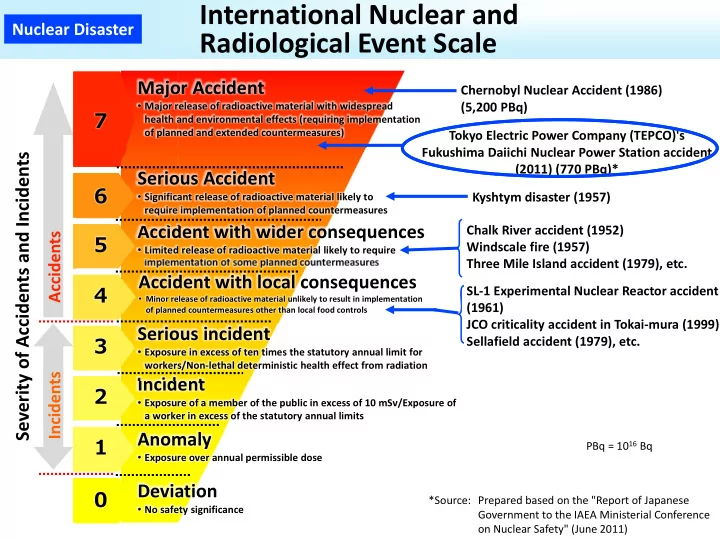

International Nuclear and Nuclear Disaster Radiological Event Scale Major Accident Chernobyl Nuclear Accident (1986) • Major release of radioactive material with widespread (5,200 PBq) 7 health and environmental effects (requiring implementation of planned and extended countermeasures) Tokyo Electric Power Company (TEPCO)'s Fukushima Daiichi Nuclear Power Station accident Severity of Accidents and Incidents (2011) (770 PBq)* Serious Accident 6 • Significant release of radioactive material likely to Kyshtym disaster (1957) require implementation of planned countermeasures Accident with wider consequences Chalk River accident (1952) Accidents 5 Windscale fire (1957) • Limited release of radioactive material likely to require Three Mile Island accident (1979), etc. implementation of some planned countermeasures Accident with local consequences 4 SL‐1 Experimental Nuclear Reactor accident • Minor release of radioactive material unlikely to result in implementation (1961) of planned countermeasures other than local food controls JCO criticality accident in Tokai‐mura (1999) Serious incident 3 Sellafield accident (1979), etc. • Exposure in excess of ten times the statutory annual limit for workers/Non‐lethal deterministic health effect from radiation Incidents Incident 2 • Exposure of a member of the public in excess of 10 mSv/Exposure of a worker in excess of the statutory annual limits Anomaly 1 PBq = 10 16 Bq • Exposure over annual permissible dose Deviation 0 *Source: Prepared based on the "Report of Japanese • No safety significance Government to the IAEA Ministerial Conference on Nuclear Safety" (June 2011)
Effects of Reactor Accidents Nuclear Disaster Note: This illustration shows possible effects in Internal general in the event of a nuclear plant Inhalation Radioactive Radioactive exposure incident or accident, and not the specific I-131, I-133, I-131, I-133, effects due to the accident at Tokyo plume plume Cs-134,Cs-137, Cs-134,Cs-137, Electric Power Company (TEPCO)'s Fukushima Daiichi NPS. Xe-133, Kr-85 Xe-133, Kr-85 I-131, Cs-137, Cs-134 I-131, Cs-137, Cs-134 From the Foods atmosphere Intake External from foods and drinks exposure Radioactive fallout Milk Cereal From the I-131, Cs-137, Cs-134 ground Cattle Plants Rivers Soil contamination Fish Drinking water (water treatment plant)
Nuclear Disaster Products in Nuclear Reactors Light‐water nuclear reactor and generation of nuclear fission products Thermal energy Decelerated Thermal energy neutron Neutron Nuclear fission Uranium‐235 Decelerated Decelerated neutron neutron Uranium‐238 Plutonium‐239 Uranium‐235 Decelerated neutron Xenon‐133, Nuclear fission products etc. Iodine‐131 Xenon‐133 Cesium‐133 Cesium‐134 Cesium‐137 Strontium‐90, etc. β‐particles γ‐rays
Radioactive Materials Derived from Nuclear Disaster Nuclear Accidents H‐3 Sr‐90 I‐131 Cs‐134 Cs‐137 Pu‐239 Tritium Strontium‐90 Iodine‐131 Cesium‐134 Cesium‐137 Plutonium‐239 Types of β β β, γ β, γ β, γ α, γ radiation 50 years *3 80 days *2 70‐100 70‐100 Liver: 20 Biological 10 days days *4 days *3 years *4 half‐life *1 *2 12.3 24,000 Physical 29 years 8 days 2.1 years 30 years years years half‐life Effective 64‐88 70‐99 10 days 18 years 7 days 20 years half‐life days days (calculated from biological half-life and physical half-life) Organs and tissues where Whole Whole Whole Liver and radioactive Bones Thyroid body body body bones materials accumulate Effective half‐life: The time required for the amount of radioactive materials in the body to reduce to half through biological excretion (biological half‐life) and the physical decay (physical half‐life) of the radioactive materials; The values are cited from the "Emergency Exposure Medical Text" (Iryo‐Kagaku Sha). Effective half‐lives are calculated based on values for organs and tissues where radioactive materials accumulate as indicated in the table of biological half‐lives. *1: Tritium water; *2: ICRP Publication 78; *3: JAEA Technical Manual (November 2011); *4: Assumed to be the same as Cesium‐137; *5: ICRP Publication 48
Comparison of Estimated Amounts of Released Radionuclides Nuclear Disaster between Chernobyl and Fukushima Daiichi NPS Accidents Release into the environment: PBq * Boiling Melting Fukushima Daiichi/ Half‐life a point b Nuclides point Chernobyl Chernobyl d Fukushima Daiichi e ℃ ℃ 5 days ‐108 ‐112 6500 11000 1.69 Xenon (Xe)‐133 〜 1760 8 days 184 114 160 0.09 Iodine (I)‐131 〜 47 2 years 678 28 18 0.38 Cesium (Cs)‐134 〜 85 30 years 678 28 15 0.18 Cesium (Cs)‐137 〜 10 29 years 1380 769 0.14 0.01 Strontium (Sr)‐90 1.5 × 10 - 2 1.9 × 10 - 5 88 years 3235 640 0.0012 Plutonium (Pu)‐238 1.3 × 10 - 2 3.2 × 10 - 6 24100 years 3235 640 0.00024 Plutonium (Pu)‐239 1.8 × 10 - 2 3.2 × 10 - 6 Plutonium (Pu)‐240 6540 years 3235 640 0.00018 Ratio of radionuclides accumulated in the reactor core at the time of the accidents that were released into the environment Nuclides Chernobyl f Fukushima Daiichi g Xenon (Xe)‐133 Nearly 100% Approx. 60% Iodine (I)‐131 Approx. 50% Approx. 2‐8% Cesium (Cs)‐137 Approx. 30% Approx. 1‐3% *PBq equals 1015Bq. Sources: a: ICRP Publication 72 (1996); b and c (except for Np and Cm): Rikagaku Jiten 5th edition (1998); d: UNSCEAR 2008 Report, Scientific Annexes C, D and E; e: Report of Japanese Government to the IAEA Ministerial Conference on Nuclear Safety (June 2011); f: UNSCEAR 2000 Report, ANNEX J; g: UNSCEAR 2013 Report, ANNEX A
Recommend
More recommend